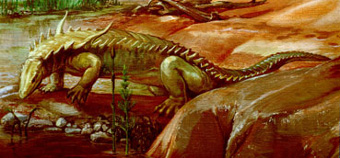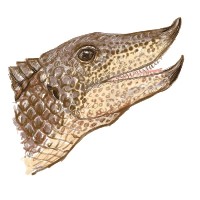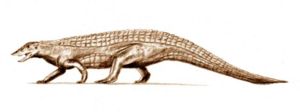
January 30, 2008
Wow, if you thought there were fights in Nessie studies and feuds among Bigfooters, you should pull the curtain aside in the serious world of paleontology sometime. Actually, you don’t have to, as Nature did it for you.

Paleontology research assistant and fossil preprator ReBecca Hunt, pictured above, notes in her blog that “name-calling” is happening, quite openly, within the field of Aetosaurs studies, as evidenced by an article published today in Nature.

“Doctoral students in the United States and Poland are accusing scientists at the Albuquerque-based New Mexico Museum of Natural History and Science (NMMNHS) of publishing articles that allegedly pilfered their research…In one instance, [the museum’s interim director Spender] Lucas, [the former director Adrian] Hunt and Justin Spielmann, the museum’s geoscience collections manager, are accused of rushing to publish a new name for an aetosaur (Rioarribasuchus) when they allegedly knew that palaeontologist William Parker of the Petrified Forest National Park in Arizona was soon to publish an article naming the species (as Heliocanthus),” proclaims Nature.

As Hunt mentions, old cryptobuddy Darren Naish was here rather early, having posted about the Aerosauria disputes back in April 2007 on his blog Tetrapod Zoology.

To be sure, these supposedly extinct creatures are interesting. There are three cryptids, worldwide, which might be surviving fossil aetosaurs or relict fossil crocodilians: Lipata (reported from the Kasai and Chiumbe Rivers, Angola), Mahamba (primarily seen in the Maika swamps of the Congo), and the Sulawesi Lake Crocodile (witnessed in this freshwater body of water in Indonesia).
The Aetosaurs (literally “Eagle Lizards”) (family Stagonolepididae order Aetosauria) are an extinct clade of heavily armoured, medium to large sized, herbivorous archosaurs.
Aetosaurs have only been found in sediments of the Late Triassic, when all the land of the world was joined together in the supercontinent Pangea. They not only resembled crocodiles superficially, but were close relatives. Both aetosaurs and crocodiles belong to the Pseudosuchia, a group that also includes the phytosaurs.
One thing is certain, they certainly have stirred up a lot of feelings and disputes among paleontologists.

++++
January 31, 2008. Darren Naish has posted an update on the “Aetosaurs Wars,” especially interesting since his April 2007 blog was the first notion that something was afoot. Please see the new Naish’s Tet Zoo blog for breaking opinions and blog links there.
About Loren Coleman
Loren Coleman is one of the world’s leading cryptozoologists, some say “the” leading living cryptozoologist. Certainly, he is acknowledged as the current living American researcher and writer who has most popularized cryptozoology in the late 20th and early 21st centuries.
Starting his fieldwork and investigations in 1960, after traveling and trekking extensively in pursuit of cryptozoological mysteries, Coleman began writing to share his experiences in 1969. An honorary member of Ivan T. Sanderson’s Society for the Investigation of the Unexplained in the 1970s, Coleman has been bestowed with similar honorary memberships of the North Idaho College Cryptozoology Club in 1983, and in subsequent years, that of the British Columbia Scientific Cryptozoology Club, CryptoSafari International, and other international organizations. He was also a Life Member and Benefactor of the International Society of Cryptozoology (now-defunct).
Loren Coleman’s daily blog, as a member of the Cryptomundo Team, served as an ongoing avenue of communication for the ever-growing body of cryptozoo news from 2005 through 2013. He returned as an infrequent contributor beginning Halloween week of 2015.
Coleman is the founder in 2003, and current director of the International Cryptozoology Museum in Portland, Maine.
Filed under Breaking News, Conspiracies, Cryptotourism, CryptoZoo News, Cryptozoologists, Cryptozoology, Fossil Finds, Media Appearances, Pop Culture, Public Forum